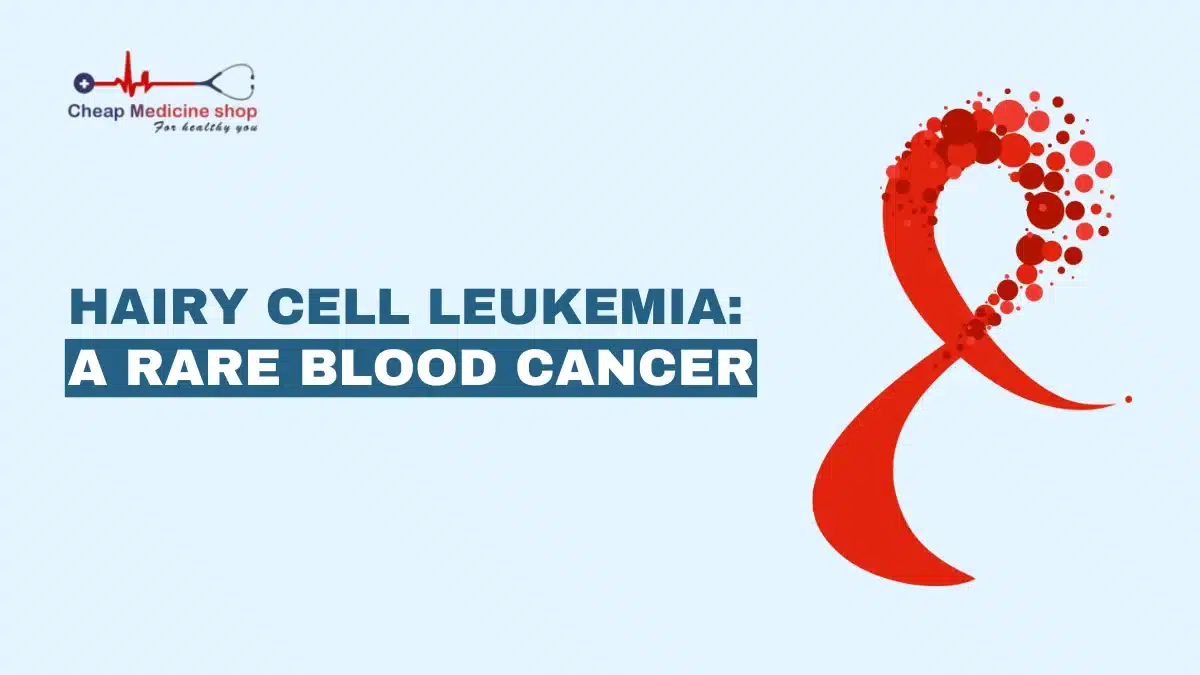Imagine waking up each day ready to work, play, learn, and laugh, only to feel tired and strange. You notice minor bruises, a slight fever, or a swollen tummy. You may wonder what is happening inside you. This journey might lead you to the possibility of a rare blood condition called Hairy Cell Leukemia.
There are many types of Leukemia, and Hairy Cell Leukemia (HCL) is one of them. You may wonder what it means for your health and daily life or how it might affect someone you care about. Hearing the words ‘Hairy Cell Leukemia’ can feel confusing. Don’t let the name make you worry; it just describes how some cells look.
This article will help you understand the condition, how doctors help, and how people live whole lives afterward.
What is Hairy Cell Leukemia?
HCL is a slow-growing Cancer that affects the blood and bone marrow. It is a rare, slow-growing Cancer of the B cells, a type of white blood cell. The name comes from the look of these abnormal cells under a microscope.
They have tiny, hair-like projections on their surface, which makes them look ‘hairy.’ These cells build up in the bone marrow and spleen, interfering with the body’s ability to make healthy blood cells.
Because these hairy cells take the place of healthy cells, your body makes fewer normal blood cells. This can cause problems like tiredness, infections, or bruising more than usual. HCL differs from other Leukemias because it usually grows slowly, and many people live for years with treatment.
Save up to 90% on your medicine bills

Abraxane 100 Mg Injection

Alphalan 5 Mg Tablets

Adriamycin 50 Mg Injection

Abirapro 250 Mg Tablet
Who gets Hairy Cell Leukemia?
HCL is rare, making up about 2% of all Leukemia cases. It is more common in white people living in the United States and other Western countries. It affects about 0.3 people per 100,000 annually in the US and Europe.
Hairy Cell Leukemia (HCL) mostly occurs in middle-aged adults, with the average age around 55. Men are more often affected than women. Scientists do not know exactly what causes HCL, but some think it might be linked to changes in genes or exposure to certain chemicals.
Hairy Cell Leukemia symptoms
The symptoms of Hairy Cell Leukemia develop slowly and can be mild at first. You might not notice symptoms early on because HCL grows gradually. But over time, you may see signs.
Common signs include:
- Feeling exhausted or weak due to Anemia (low Red Blood Cells)
- Frequent infections because of low White Blood Cells
- Easy bruising or bleeding from low platelets
- A swollen or tender spleen, which may cause discomfort or fullness in the belly
- Weight loss or night sweats (less common)
- Rarely, bone pain or lesions
You must see a doctor for a check-up if you notice these signs. Since symptoms are often subtle, HCL may be found during routine blood tests before symptoms appear.
Causes of Hairy Cell Leukemia
Doctors are not sure what causes HCL. The exact reason for HCL is not fully understood. It is linked to changes in the DNA of B cells.
Genetic mutations, especially in the BRAF gene, BRAF V600E, occur in many cases. This mutation causes cells to grow and survive when they should not.
Some individuals also have CDKN1B (a gene) changes. These mutations make B cells grow too much.
Other factors, like exposure to certain chemicals or radiation, have not been linked. Chemical exposures, such as certain solvents, may raise the risk.
How is Hairy Cell Leukemia diagnosed?
Doctors use several tests to find out if someone has HCL:
- Physical exam: Doctors check if your spleen or liver is larger than usual.
- Blood tests: These check how many blood cells you have. A Complete Blood Count (CBC) shows low red cells, white cells, and platelets. Low counts can be a clue.
- Hairy Cell Leukemia blood smear: A microscope helps examine a blood sample. The hairy cells have a distinct look with projections and a pale blue cytoplasm. This is called the Hairy Cell Leukemia peripheral smear.
- Bone marrow biopsy: A small sample of it is taken to check for hairy cells. The bone marrow often shows a ‘fried egg appearance,’ where the cells have clear cytoplasm around the nucleus.
- Flow cytometry for Hairy Cell Leukemia CD markers: This test looks for specific proteins on the surface of hairy cells, such as CD19, CD20, CD22, CD25, CD103, and CD123. The presence of CD25 helps distinguish classic HCL from a variant form.
- Molecular tests: These check for the BRAF V600E mutation to confirm diagnosis.
- Imaging tests: Ultrasound or CT scans can measure spleen size and help determine how far the disease has spread.
These tests help doctors confirm the diagnosis and plan the best treatment. Hairy Cell Leukemia pathology outlines support the diagnosis, describing the cell shapes, staining patterns, and tissue involvement.

Under the microscope, hairy cells with oval or indented nuclei are small to medium-sized. The cytoplasm is pale blue and has irregular hairy projections. The bone marrow biopsy usually shows a pattern where hairy cells are spread out with a clear space around each cell, giving the look of a ‘fried egg.’ The marrow may be fibrotic, causing a ‘dry tap’ during aspiration (failure to withdraw marrow fluid due to marrow being replaced by fibrous tissue).
Spleen: It is an organ that helps filter your blood and fight germs.
Dry tap: When doctors try to take a sample of bone marrow by suction (called aspiration), sometimes they cannot get any liquid marrow. This is called a ‘dry tap.’
Hairy Cell Leukemia treatment and its side effects
Treatment depends on symptoms and disease severity. Not everyone needs immediate therapy if symptoms are mild.
HCL is not curable, but it is treatable. Treatment usually lasts a few weeks, and many individuals achieve remission, meaning the disease is under control. However, relapses can happen, and they might need additional treatment.
Many people respond well to therapy and can live for many years. The main medications (chemotherapy) and common medications for Hairy Cell Leukemia include:
- Purine analogs like Cladribine and Pentostatin are chemotherapy treatments. They are effective in killing hairy cells and inducing remission. They allow healthy blood cells to grow again. These are proven and trusted for treating HCL.
- For patients who do not respond well to chemotherapy or relapse, doctors may use newer treatments like targeted therapies that focus on specific gene changes in hairy cells.
For example, targeted therapy such as BRAF inhibitors (e.g., Vemurafenib) may be used for those with the BRAF mutation who relapse or do not respond to standard treatment.
- Monoclonal antibodies like Rituximab. These can be combined with chemotherapy to improve outcomes.
- Interferon-alpha, which was used in the past but is less common now.
- Sometimes, you may need supportive care, such as antibiotics to fight infections or blood transfusions if your blood counts are very low.
If the need for chemo arises, most would like to be aware of side effects so that they can be mentally prepared to some extent. Chemotherapy drugs for HCL are generally well tolerated but can cause side effects such as:
- Low blood counts leading to infections, Anemia, or bleeding
- Fatigue
- Nausea
- Hair loss (less common)
- Allergic reactions
Your doctor will keep an eye on you closely and provide supportive care.
Hairy Cell Leukemia diet and lifestyle
While no specific diet cures HCL, eating a balanced, nutritious diet supports your immune system and overall health. To avoid infections, practice good hygiene and stay away from people who are sick.
Focus on:
- Plenty of fruits and vegetables
- Lean proteins
- Whole grains
- Staying hydrated
Hairy Cell Leukemia prognosis and survival
The outlook for an individual with HCL is generally favorable. With modern treatments, many people live long, quality lives. Studies show that many individuals stay free from the disease for 10 years or more after treatment.
The 5-year survival rate is about 96%, and the 10-year survival rate is about 87%
Women tend to have a slightly better outlook than men. It is critical to have regular follow-ups with your doctor. They will check your blood and bone marrow to watch for any signs of the disease returning.
Factors that affect prognosis include:
- Stage of disease at diagnosis
- How well the disease responds to treatment
- Overall health and age of the individual
Younger people and those who respond well to treatment tend to have better survival rates.
However, a HCL variant (HCL-V) is problematic. It is a less common form that behaves differently and is harder to treat.
HCL-V does not have the BRAF mutation and may need different therapies. If you or someone you know has HCL, doctors will test to see which type it is to choose the best treatment.
Conclusion
Hairy Cell Leukemia (HCL) is a rare but treatable Blood Cancer that affects B lymphocytes. It grows slowly and causes low blood counts and spleen enlargement. Common symptoms include fatigue, infections, bruising, and abdominal discomfort.
Doctors diagnose HCL through blood tests, bone marrow biopsies, and specific lab tests for cell markers. Treatment primarily involves chemotherapy drugs like Cladribine, which effectively manage the disease. Many patients live long lives after treatment, though some may experience relapses. A variant known as Hairy Cell Leukemia Variant (HCL-V) requires different treatment options.
If you or a loved one has symptoms or concerns about HCL, talk to a healthcare professional for a proper diagnosis and care. This information is for educational purposes only and should not replace medical advice.

Frequently Asked Questions
Is Hairy Cell Leukemia a lymphoma?
No, Hairy Cell Leukemia (HCL) is not exactly a lymphoma. It is a rare type of Blood Cancer that affects specific White Blood Cells called B lymphocytes. While it shares some features with lymphomas, HCL mainly affects the blood and bone marrow, unlike lymphomas, which usually affect lymph nodes
Can Hairy Cell Leukemia spread?
Yes, HCL can spread. The Cancer cells form in the bone marrow and blood, and sometimes they can move to other parts like the spleen, liver, or skin. This spreading can cause problems in those organs and affect your health. However, it usually grows slowly.
Can Hairy Cell Leukemia lead to Bone Cancer?
No, HCL does not usually lead to Bone Cancer. However, in rare cases, the disease can affect bones and cause bone pain or damage. This happens because hairy cells sometimes invade the bones, which is not the same as Bone Cancer. Most people with HCL do not get Bone Cancer.
Can Hairy Cell Leukemia grow outside the body?
No, HCL cannot grow outside the body on its own. It is a Cancer that affects your body’s blood and bone marrow. Sometimes, the Cancer cells spread to organs like the spleen or liver, but they do not grow outside the body like a lump on the skin.
Cheap Medicine Shop only refers to credible, authoritative sources for our content. If you’re curious about how we ensure the integrity of our content, we encourage you to read our Content Information Policy.












